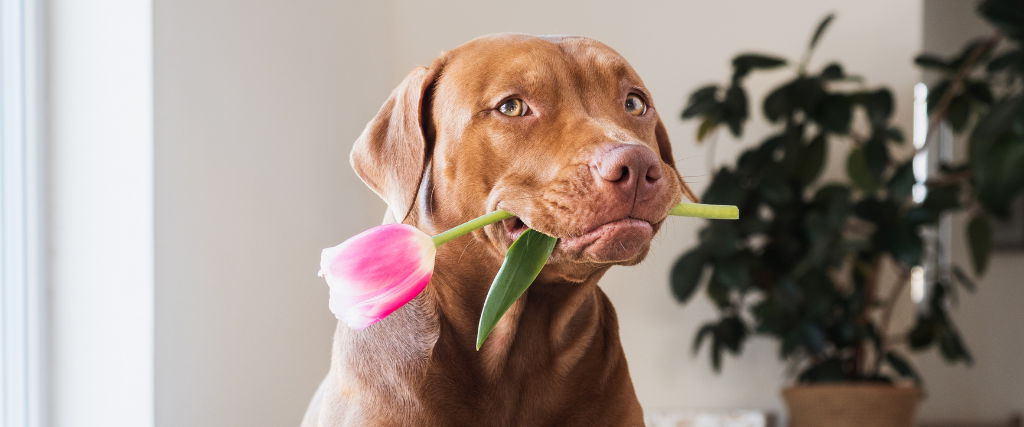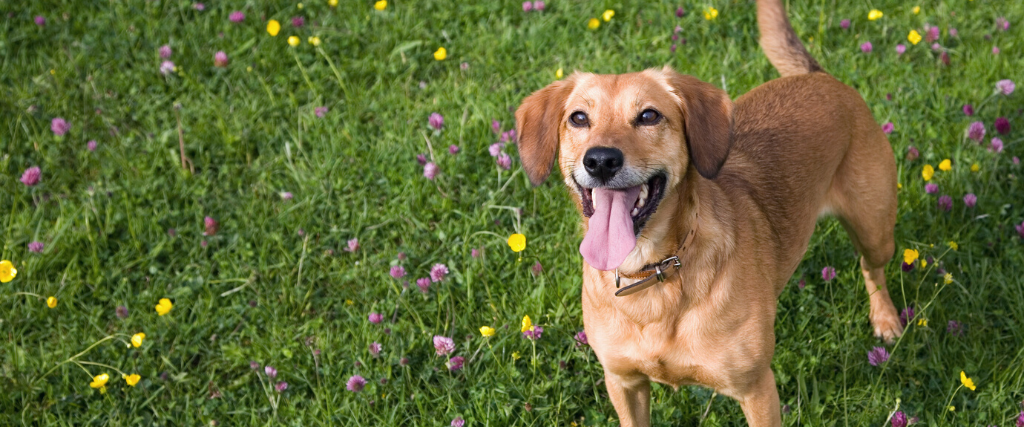Ahh do you smell that sweet scent in the air? Spring is almost here! With the warmer weather and seasonal blooms, there are many wonderful things that come with the season. However, there are also a variety of Spring toxins that can pose a risk for your precious canine. Here are the top Spring toxins, from plants to food to cleaning products, that your dog needs to avoid.
I know some plants are toxic to cats but are they toxic to dogs?
Most cat owners know about the dreaded lily and how they are extremely toxic to cats. However, there are a number of plants that can spell danger for both cats and dogs. Here are a few of them:
Sago Palm
These ornamental outdoor plants are quite common in warmer climates. Unfortunately, they are extremely toxic to both cats and dogs. If ingested by a curious pet, the pet could suffer liver failure and even death if not treated immediately.
Tulips
A popular springtime flower, the toxins present in the tulip are concentrated in the bulb of the plant. This means that if your dog or cat comes into contact with the tulip bulb, they could be at risk of poisoning. Signs of toxicity include vomiting, diarrhea, excessive drooling, and depression.
Begonias
Begonias are a popular plant for gardens as they are easy to grow and have gorgeous blooms. But like the tulip, these plants house their toxins in the bulb or the stem of the plant. If ingested, this can cause serious burning and irritation of the mouth, throat, tongue and lips, excessive drooling, vomiting, and difficulty swallowing.
Hyacinths
Hyacinths contain alkaloids which are considered severely toxic to pets. Ingestion of this plant can cause vomiting, diarrhea, depression, and tremors in both dogs and cats.
Buttercups
With their stunning and vibrant hues, buttercups invoke the season of spring. But don’t go frolicking about in a field of buttercups with your pet as this plant is very toxic to them! Even a small nibble of the flower can cause vomiting, diarrhea, excessive drooling, and walking incoordination.
This is just a small sampling of some of the more common spring plants that tend to populate homes. ASPCA has a fantastic database listing the plants that are toxic and non-toxic to dogs, cats, and other animals and it can be found here.

How do I know if my lawn treatments are toxic to my dog?
As you start prep on your lawn to have it ready to enjoy for spring and summer, you should know that there are a number of lawn treatments that can pose a toxic risk for your pet. Blood meal is an organic fertilizer that is made from dried, ground and flash-frozen blood and contains 12% nitrogen. Blood meal can seem particularly attractive to pets as it smells like cow or fish. However, if ingested, your pet could experience symptoms such as vomiting, diarrhea and severe pancreatitis, or inflammation of the pancreas.
Pesticides and insecticides are other lawn treatment products that can be a danger to your pets. While most of these products are basic irritants to pets if they come into contact with them, you should seek out your veterinarian if your pet displays signs of discomfort and their symptoms persist. Additionally, if your pet happens to ingest the product directly from the container or bag, then you should take them to the veterinarian immediately as this can become a life-threatening situation.
Plant fertilizers can contain disulfoton or other types of organophosphates, which a small amount could be fatal to a pet if ingested and should be kept away from pets at all times. Additionally, iron can be added to lawn fertilizers and could result in iron toxicity if your pet happens to ingest it.
When using lawn treatment products, it is imperative that you read the product labels, use the products as directed, and use the appropriate amounts. Pay attention to warning labels on lawn treatment products so you can determine which products would be the best and safest option to use around your home and pets.
Are there any spring cleaning products I need to worry about?
The short answer is YES. As a pet parent, you always need to be mindful of the products that you regularly use around your home, especially when it comes to cleaning products. Bleach is a popular cleaning product that is found in most homes. However, if you were to use straight bleach without diluting it, bleach can irritate the skin of your pets and be especially toxic if ingested, such as your pet licking their paws after they stepped on a surface cleaned with undiluted bleach. When diluted and used properly, bleach can be used as a cleaner throughout the home, so be sure to use bleach as directed on the label and keep pets away from items cleaned with bleach until the items are completely dried.
Other cleaning products can contain ingredients that are not only toxic to pets but can also be toxic to people. These are ingredients such as ammonia, chlorine, glycol ethers, formaldehyde, etc. and can be found in various cleaning products. It’s imperative that you check the labels of cleaning products as to avoid using products that can be especially harmful to your pets.
If you do choose to use cleaning products containing toxic ingredients, be sure to carefully read the labels, use the products properly, and carefully store products out of reach of pets when not in use.

What kinds of food are toxic to dogs?
As pet owners, we love treating our pets as part of the family. However, that doesn’t mean that we can treat our pets to the same food that us humans eat, as some of them can be highly toxic to them. Here are some foods that your dogs should steer clear of:
Chocolate - All chocolate, especially dark and baking chocolate, is toxic to dogs.
Macadamia nuts - Just a handful of nuts can make your dog experience symptoms such as vomiting, muscle shakes, fever, and weakness in their back legs.
Grapes/Raisins - Even a small amount of grapes and raisins can cause kidney failure in dogs. Other signs of toxicity including constant vomiting, fatigue, and depression.
Xylitol - This artificial sweetener is commonly found in sugar-free foods such as candy, gum, baked goods and even toothpaste! Xylitol can be especially dangerous as it can cause a drop in blood sugar and lead to liver failure.
Onions and Garlic - All forms of onions and garlic (raw, cooked, powdered, dehydrated) are incredibly toxic to dogs and can cause anemia, weakness, vomiting, and breathing problems.
Coffee, Tea, and Caffeine - Caffeine can be fatal to dogs and thus all products containing caffeine should be kept away from your canine. This includes colas, energy drinks, and medications. If you believe your pet ingested caffeine, they should be taken to the veterinarian immediately.
Although there are lots of human foods that your dog should never eat, there are a couple of healthy human food options and some DIY treats you can make for Fido to enjoy. Raw veggies such as carrots, cucumbers, and lettuce make great treats for your pup while you can make some tasty frozen treats out of strawberries and peanut butter. Just be sure to feed your pet human treats in moderation as each pet is different and may have different dietary needs.
What are the signs of toxicity in dogs?
Signs of toxicity can range from vomiting to more serious symptoms such as seizures. Here are some of the most common signs that your dog may of gotten into something poisonous:
- Vomiting
- Diarrhea
- Abnormal heart rate
- Lower blood pressure
- Breathing issues
- Lethargy
- Balance issues
- Excessive drooling
- Pale gums
- In serious cases: liver failure, kidney failure, seizures
If your pet is displaying signs of toxicity, they should be seen by a veterinarian immediately. You can also contact ASPCA Animal Poison Control for any animal poison related emergency on their 24/7 hotline. Contact us if you have any further questions regarding springtime toxins!
